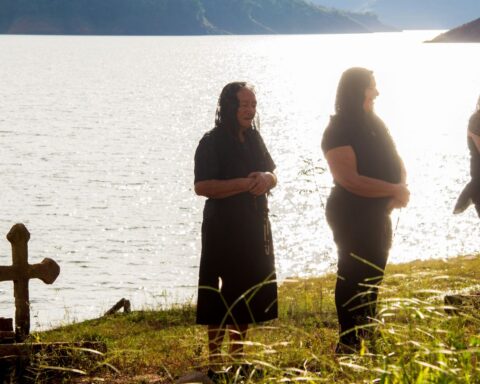Thom Powers is the veteran curator of TIFF Docs. At TIFF, he has programmed premieres for such filmmakers as Morgan Spurlock, Jonathan Demme, Werner Herzog and Kevin Rafferty. He runs the annual Doc Conference at TIFF, which features talks about key issues in the industry, on-stage interviews with filmmakers and presentations on new developments in the documentary world. Since 2010, Powers has been the artistic director of DOC NYC, one of the fastest growing documentary festivals in the world. Previous to his time as a curator, Powers produced and directed independent docs.
POV’s editor Marc Glassman caught up with Powers in the week before TIFF. Here is an edited version of their interview.
MG: Marc Glassman, POV
TP: Thom Powers
MG: Thom, this seems like a particularly good year doesn’t it?
TP: I think it does. There are returning friends to the festival like Sophie Fiennes and Frederick Wiseman and Matt Tyrnauer and then there’s some other filmmakers who I’ve long respected but who’ve never played at TIFF before like Brett Morgan and Heidi Ewing and Rachel Grady. And then always a new crop of filmmakers, whom I’m looking forward to having audiences discover.
MG: You’ve gone out of your way to find documentaries from other parts of the world. For example, The Judge by Erika Cohn—how amazing to have a Jewish filmmaker make a film about a Palestinian judge.
TP: In the case of The Judge, my colleague Dorota Lech who has produced the Hot Docs Pitch Forum, had seen Erika pitch the project. It was Dorota who first drew my attention to the film. Erika had previously made another film, In Football We Trust, a couple years ago, so I had a bit of knowledge of her work, but this film really impressed me. To your point about the international scope, that’s something, which is a big part of the mandate of TIFF.
MG: I was a big fan of Yilmaz Guney’s Yol, which was hugely controversial back in the 1980s. Can you tell me about the doc on him?
TP: The Legend of the Ugly King is terrific. I have to admit that I’d never seen Yol, and had never heard of Yilmaz Guney even though TIFF did a retrospective of his work in 2012. So it’s my own blind spot that I didn’t know his work. But I tell that to you because any audience member who shares my cultural blind spot will find this film is totally rewarding even if you don’t know anything about Yilmaz Guney One thing that struck me about Ugly King was that Guney was as a very inspiring figure of resistance—he was someone who had a vision of bringing together Turks and Kurds and Arabs, which now several decades after his death is still a worthy goal although maybe more distant than in his lifetime. His spirit of resistance and ability to persevere no matter what the opposition was doing is inspirational. Even from jail, he was able to direct his film Yol [through instructions, which were meticulously followed by his assistant]—and it went on to win the Palme d’Or at Cannes.
That spirit of resistance also comes through strongly in the film Silas, about the Liberian activist Silas Siakor. It comes through in the film from Serbia called The Other Side of Everything by Mila Turajlic, which is a profile of her mother Srbijanka Turajlic, who was a dissident under Milosevic and continues to be outspoken today in Serbia. I spent time this summer viewing these films and when I wasn’t doing that, I was watching the news and following people trying to stand up to powerful interests. Those films resonated very strongly with me.
MG: One more that I was curious about was Makala — it’s interesting about Cannes that in spite of the glitz they still go for these social justice films.
TP: That’s an accurate observation. This year at the Cannes Film Festival I had the pleasure to serve on a documentary jury, which is only in its third year. It’s called the Golden Eye jury. It was started by an outside organization but has the stamp of approval from the festival and our jury president was the French actress Sandrine Bonnaire, who has also made documentaries in her career. We gave a special jury prize to Makala alongside the top prize that it got from the Critics’ Week jury. And then we gave our top prize from the Golden Eye jury to Agnes Varda’s collaboration with the street artist JR called Faces Places, which is also playing at Toronto. If I could tell your readers to see only one documentary this year I would tell them to see Faces Places.
MG: I’m a huge fan of Varda. Can you tell me more about the film?
TP: Going into Cannes, knowing that there’s a new Agnes Varda film, and that she’s in her late 80s, part of me wondered if this was going to be something light, more of a sketch than a fully realized film—which I would’ve been happy to watch! And I saw that she was collaborating with this street artist JR whose work I didn’t really know at the time so I wasn’t sure what that was going to mean. But I have to say that the results went far beyond my expectations for it. Their collaboration is really a rich one. A filmmaker in her 80s and an artist in his 30s. One of the themes of the film is reaching out across generations. His street art has a lot to do with taking photographs of people and then blowing them up and wheatpasting them to the sides of buildings that represent people who are overlooked in their communities. In this film we’re going to lots of areas of France that we don’t often see in films like a coal-mining town, industrial shipyards, factory towns. Each scene is a new revelation of what Agnes Varda and JR are able to do out of this artistic collaboration.
MG: You’ve programmed a film by another of my favourites, Fred Wiseman. Can you tell me more about his film on the New York Public Library, Ex Libris?
TP: Well, let’s talk about octogenarian filmmakers who just continue to impress us! Agnes Varda, Frederick Wiseman, Alanis Obomsawin are three at this year’s festival. Wiseman has had seven films at TIFF in the last nine years. They include La Danse, which is his highest-performing theatrical documentary ever. With Ex Libris, Wiseman continues his exploration of cultural institutions, which has included in recent years the National Gallery, U.C. Berkeley, and the Paris Ballet. In this film he is doing the things that he does so well in looking at an organization from its top leaders down to its bottom workers while capturing a sense of society at a particular time. The subject of race is closely intertwined in Ex Libris, probably because the New York Public Library includes the Schomburg Center, the great library of African American studies.
MG: Can you talk about the use of archival footage in Brett Morgen’s film about Jane Goodall? He always comes up with unique ways to make a doc.
TP: To say it’s archival footage under explains what’s going on here. It’s true with Brett Morgen’s work that with each film he finds a different visual way to tell the story, whether it was the still image motion graphics he used in The Kid Stays in the Picture or animation that he used in Cobain: Montage of Heck. In this case he has access to 140 hours of exquisite 16mm footage shot of Jane Goodall in her 20s in her first year or so in Gombe Stream National Park. There’s a new score by Philip Glass for Jane and it plays like a romantic epic, as we see her as someone quite young encountering chimpanzees.
MG: Sophie Fiennes is another sophisticated storyteller. What risks does she take in Grace Jones: Bloodlight and Bami?
TP: This is a film that is as unconventional as its subject. Sophie Fiennes is another filmmaker who, with each film, is finding a different visual style to tell her stories. We’ve seen her make two films about the philosopher Slavoj Zizek; she made a film about the artist Anselm Kiefer; and her first feature-length documentary was about Grace Jones’ brother, the preacher Noel Jones in Hoover Street Revival. Each one of those films brings a style suitable to its subject and that’s true again in the Grace Jones film. This is not your typical music biography where she’s collected some archival footage and sat down and done a long interview with Grace Jones. She’s been filming for ten years with Grace Jones who’s a constantly moving target: one scene she’s in Jamaica, then she’s in New York, then she’s in Paris, then she’s in London. Sophie is along for that ride and we get to be too. It’s more about immersing us into the world of Grace Jones. Interspersed in those scenes is a performance that Jones staged in Dublin last year specifically to be filmed by Sophie Fiennes with a live audience. The subtitle to this film is Bloodlight and Bami: Bloodlight refers to the red light above a studio when it’s in session and Bami is a kind of Jamaican bread. Those two words represent art and life and that’s what we’re getting in this film, Grace Jones’ art and life.
MG: How about Boom for Real? Sara Driver would’ve known Jean-Michel Basquiat. Is this film not just a look at Basquiat but also an evocation of that time in New York?
TP: Yes, your instincts are correct. One of the things that I appreciate about this film is that the people who are interviewed in it really knew Basquiat personally. It’s not like they’ve interviewed the New York Times art critic who only knows his work. Much of the film is about the scene in New York in the late 1970s and early 1980s when artists and musicians and filmmakers were eking out livings in downtown Manhattan and influencing each other. It was an exciting time when the whole cultural structure was changing with all the old guard institutions of establishment art galleries, movie studios and record companies being transformed by this do-it-yourself environment.
MG: Thom, what was it like programming in the Trump era? You talked earlier about resistance films. Can you tell me about other choices, such as China Hustle and Final Year?
TP: In our submissions this year we saw a lot of films that were taking on the election directly. I think that a challenge those films face is that our daily news is constantly processing that election and its aftermath on a daily basis. It’s hard for a documentary filmmaker to get a fresh perspective because it seems that every topic has been chewed over before a film can be released or events move so quickly that stories become stale-dated. In the case of the Final Year, I felt that it spoke most eloquently about the times we’re living in now by contrasting it with the times we were living in just a year ago with a very different administration in the White House. I think for filmgoers who miss the Obama administration, this is a 90-minute time machine that you can climb into and go back to witness it again. What Greg Barker has that’s so unique in this film is access to Obama’s key foreign policy advisors including Samantha Power and Ben Rhodes, speechwriter, and Secretary of State John Kerry. Something that becomes clear in the film that perhaps I didn’t even appreciate enough at the time they were in office is the way in which they were really trying to conduct foreign policy in a different way than it had been before: less militaristically, with more diplomacy. One thing that I would say about this film is that because it’s an observational documentary in 90 minutes covering a year’s worth of time, you’re not going to get deep policy detail. You’re going to have to wait for people’s memoirs or history books for that. What you do get is that sense of being there, which Ricky Leacock used to talk about, and what he and his colleagues captured so well in those pioneering works of the 1960s like Primary and Crisis. I feel this is a film that carries on that tradition.
The other film, China Hustle, continues in a tradition of other financial scandal docs like Inside Job and Enron: the Smartest Guys in the Room. The executive producers on this film are Alex Gibney and Frank Marshall, working with a director who’s primarily worked in television, Jed Rothstein, but brings great investigative chops into the documentary form. This film is an alarm over the US stock exchange and some of its practices and the international financial industry in general. It speaks directly to our times when the Trump administration is talking about deregulating banks further; you can see very clearly in this film the tremendous risks to our financial system when financial institutions lack regulation.
MG: How about a very quirky film, Jim and Andy?
TP: Chris Smith has such a strong track record, from American Movie to Collapse—speaking of financial scandals—so I’m always interested in what he’s doing. This film came out of the blue. I didn’t know that he was working on it or that this footage existed. You’ll remember Jim Carrey’s portrayal of Andy Kaufman in Man on the Moon. During the making of that film, over the few months that it was in production, Jim Carrey more or less stayed in character, both on screen and off—and there was a video crew following him around for a lot of that time. The footage was never released; someone says in the film that the studio publicist forbade it from being released because they were afraid that people would hate Jim Carrey if they saw it. Now, with Jim Carrey’s permission, Chris Smith has gotten his hands on the footage and is collaborating with Jim Carrey in a long reflective interview about that period of his life. It’s a film about two boundary-breaking artists, Andy Kaufman and Jim Carrey: it’s a dual artistic portrait, and if you’re interested in either one of them, it’s a fascinating film.
MG: With both of them, you never really knew if they were putting you on.
TP: There are definitely mind-fuck moments.
MG: How about Morgan Spurlock and Supersize Me 2?
TP: I think it’d be fair to ask, what more could he possibly add to Supersize Me, and the answer is quite a bit! The original Supersize Me, 12 years ago, played a strong role in changing fast food industry. One of the changes that we’ve seen to fast food over the years is now when you walk into a restaurant, you see things advertised as natural and organic and healthy. Morgan decided he wanted to find out what that means by opening his own chicken restaurant. We watch him find out what it really mean to raise healthy chickens and bring them to a marketplace that has certain expectations.
I think this is Morgan’s strongest work since Supersize Me. The film is as much about language as it is about food because one of the things that you come to realize is that not much has changed around fast food except for the language they use to describe it. We’re still eating the same factory-made products but now we are allowed to feel a little bit better about it because it’s packaged in a different way. The message of this film goes beyond just thinking about food, it makes us think more carefully about language in all aspects of our lives and how we are sold things, whether it’s a product or a politician, based on language. What does that language mean?
MG: What can you tell me about One of Us, Heidi Ewing and Rachel O’Grady’s new doc about the Hasidim in New York.
TP: At times, their film feels like a thriller, particularly in one case when a woman named Etty, who is trying to escape an abusive marriage but has several children, has to make a very hard decision. She’s stuck in a situation where if she leaves her marriage, she may be losing access to her children. There are times when this film feels like a thriller where you don’t know what she’s going to do. That’s a really strong film.
M.G.: How about recommending one more doc, Thom?
T.P: Sure. Scotty and the Secret History of Hollywood by Matt Tyrnauer: Scotty Bowers is the keeper of more Hollywood secrets than any three other people. He’s now 94 years old and yet he’s still in better shape than most people I know who are a couple of decades younger. I can’t wait for audiences to see that film. It has a touch of Grey Gardens about it in that Scotty in his older years is quite a hoarder. You get a sense of him unpacking—literally and figuratively unpacking—his life. The namedropping is beyond belief in the film.
Marc, I should tell you that we’ve uploaded an episode of Pure Nonfiction, my podcast, which has a TIFF preview where you’ll hear a lot of clips from the films I’ve discussed with you. Dorota and I did a conversation in two parts; we cover a lot of these films and you’ll be able to sample clips from them.









